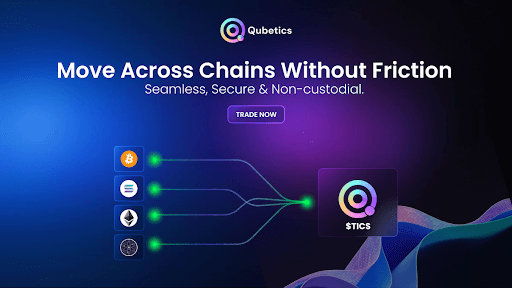Can Qubetics, Ethereum, or Kaspa be the top performer of the next breakout cycle? As digital assets continue attracting fresh inflows, identifying the right entry point has become more important than ever. Qubetics ($TICS) made a remarkable debut by climbing from $0.40 to an all-time high of $4.20 within just 60 minutes of launch. That 950% growth in one hour is now backed by over $700,000 in volume on MEXC, a support level forming at $2, and consistent buzz keeping it trending among the top 10 on CoinMarketCap. While the crypto market is seeing high volatility, the performance of newer tokens like Qubetics indicates that momentum is shifting toward utility-driven projects.
Ethereum is showing renewed strength, largely driven by the proposed introduction of a gas fee cap and increased whale staking, while Kaspa’s technical charts have sparked conversations around a sharp decline followed by potential medium-term gains. All these developments are shaping what could be the framework of the next bull run crypto lineup. With each project charting its own growth pattern, the comparisons between them are now more relevant than ever. And if recent market action is any indication, Qubetics might be setting the tone for a new generation of Layer 1 dominance.
Qubetics Pushes the Boundaries of Global Payments
Cross-border transfers have long suffered from delays, high fees, and limited transparency. Qubetics offers a streamlined solution, leveraging blockchain architecture to deliver near-instant, borderless transactions. This is not just another payment rail. By enabling direct Layer 1 interoperability with Bitcoin and other major networks, Qubetics eliminates the need for bridges or third-party conversions, meaning transfers are faster, cheaper, and more private. No KYC, no high processing costs, just frictionless value exchange.
A simple example: a business transacting with multiple suppliers in different regions no longer needs to rely on third-party conversions or banks. Qubetics supports these interactions through a single point, removing the technical bottlenecks typically faced in fragmented ecosystems. These capabilities make Qubetics a powerful contender among next bull run crypto projects. Not only does it meet institutional needs for liquidity and speed, but it also empowers individuals to send remittances and make international payments with unmatched efficiency.
Qubetics Brings DPoS Voting and Staking to the Forefront
Qubetics uses Delegated Proof of Stake (DPoS) to power its governance and network security. This structure places control in the hands of token holders who either validate blocks or delegate their stake to trusted validators. Validators must hold at least 25,000 $TICS, while delegators need a minimum of 5,000 $TICS to earn a portion of the validator’s 30% APY. By combining decentralization with efficiency, Qubetics ensures high uptime, strong consensus, and fair reward distribution. The Delegated Proof of Stake (DPoS) model allows broader community participation, without compromising speed or reliability.
Qubetics Price Performance and Future Outlook Paint a Bold Picture
From a presale price of $0.01 to a public listing at $0.40 and reaching $4.20 within the first hour, Qubetics recorded a 420x return from its earliest entry point. That equates to a 41,900% return. For example, a $10,000 investment during presale would have turned into $4.2 million if sold at the all-time high. The token raised $18.4 million during its presale, distributing over 517 million tokens to more than 28,500 early participants. With over $700,000 traded on MEXC in the first 24 hours and a steady support level now holding at $2, Qubetics continues to draw high-volume interest.
Market participants are also attracted to its 30% APY for validators, low-friction cross-chain capabilities, and no-KYC transactions. As more features roll out post-mainnet, analysts are projecting a price range of $10 to $15 for Qubetics in the coming months. The token’s interoperability, combined with Delegated Proof of Stake (DPoS) staking, positions it firmly within the conversation for the next bull run crypto.
Kaspa Forecasts Signal Caution Before Potential Lift-Off
Kaspa is currently showing mixed projections. Some models estimate a nearly 25% decline from current prices in the short term, suggesting a price dip to around $0.0566 by August. This has sparked caution among market watchers, especially with momentum indicators showing a Fear & Greed Index at elevated levels. However, long-term models suggest a significant rebound, projecting price growth of over 170% by early 2026. These divergent paths highlight the asset’s volatility. While the long-term case for Kaspa remains bullish according to some forecasts, its current trend appears to be under pressure, requiring patience and timing for those considering entry.
Ethereum’s Gas Reform Pushes It Toward a Key Breakout
Ethereum has bounced back after a short dip, now trading close to $2,585. Market activity has surged, with 24-hour volume increasing by over 70% to reach nearly $15 billion. A proposed gas cap of 16.77 million per transaction is now under review, aiming to make fees more predictable and unlock efficiency for smart contracts and zero-knowledge applications. On-chain data shows whale activity increasing, with several million dollars in ETH recently moved off exchanges into staking pools. Technical indicators point to $2,800 as the next major resistance level, with analysts calling for a breakout that could push Ethereum to $3,500 or higher. These updates suggest Ethereum remains a strong competitor in the next bull run crypto race.
Conclusion: Three Projects to Watch in the Next Bull Run Crypto Cycle
The race to be the next bull run crypto is heating up. Qubetics has proven its strength through real-world application, record-setting price action, and a validator system that offers 30% APY. Its Delegated Proof of Stake (DPoS) model makes it not only scalable but also highly community-driven, while features like cross-chain compatibility without bridges or KYC enhance its adoption potential. Ethereum, on the other hand, is refining its base layer with reforms aimed at stabilizing transaction costs, while rising whale activity and bullish price indicators support a continued upward move. Meanwhile, Kaspa offers a high-risk, high-reward proposition, with a steep projected dip followed by longer-term optimism based on growth models.
For participants seeking the best crypto to buy now, each of these projects offers a different approach, Qubetics leans on fresh infrastructure and high ROI scenarios, Ethereum on reform and resilience, and Kaspa on volatile pricing with upside potential. Their unique attributes place them squarely in the spotlight as the next crypto cycle takes shape.
For More Information:
Qubetics: https://qubetics.com
Telegram: https://t.me/qubetics
Twitter: https://x.com/qubetics
FAQs
What is the next bull run crypto for 2025?
Qubetics, Ethereum, and Kaspa are emerging as strong contenders for the next bull run crypto based on recent performance and upgrades.
Is Qubetics using Delegated Proof of Stake (DPoS)?
Yes, Qubetics utilizes Delegated Proof of Stake (DPoS), allowing token holders to earn through validator and delegator roles while securing the network.
Which is the best crypto to buy now for long-term value?
Based on APY returns, strong launch data, and practical features, Qubetics currently presents itself as one of the best crypto to buy now.
Summary:
This blog reviewed the performance and future outlook of three potential next bull run crypto assets: Qubetics, Ethereum, and Kaspa. Qubetics has surged with a 950% first-hour gain, 30% APY validator rewards, and top-tier interoperability. Ethereum is strengthening on gas reform and whale interest, eyeing $3,500 levels. Kaspa is facing near-term bearish projections but remains on the radar due to potential 172% long-term returns. Each token offers a unique value proposition and plays a different role in the current and upcoming crypto cycle.




